Men of Cryptozoology: Scott Norman
Posted by: Loren Coleman on October 23rd, 2007
Mokele-mbembe art courtesy of Bill Rebsamen. Click on image for a larger view.
Scott T. Norman recently journeyed from California to the East Coast of the USA. He attended the Mass Monster Mash on October 13, and on the occasion of the 40th anniversary of the Patterson-Gimlin Film, happened to visit me, along with five members of his family, at the International Cryptozoology Museum in Portland, Maine.
Scott is a cryptozoologist who has taken his passion for dinosaurs, Mokele-mbembe, and prehistoric cryptids, all the way to Africa. He definitely ranks as one of the Men of Cryptozoology. Let’s meet him today.
Scott T. Norman was born March 15, 1964 in Salinas, California, to a cheerful mother (a school librarian) and a thoughtful father (involved in the agriculture industry). Scott grew up with an interest in dinosaurs, as so many boys often do.
This strong fascination with dinosaurs, supported by his friends, family, and co-workers, translated in the early 1990s into an introduction, through his work, to Herman Regusters.
Regusters had been to the Congo in search of Mokele-mbembe, a possible living dinosaur. Scott talked to Herman and was fascinated by what he had to say. Indeed, Scott was intrigued by the video Regusters had created about his trip and Herman’s hopes for the possibility of another trip in the future.

Herman Reguster.
At that time, Scott stored the information about those African dinosaurs in his head. He pondered the possibility of living dinosaurs, but did not pursue the subject yet.
Then, a couple years later, in early 1996, Scott stumbled upon Roy Mackal’s book, A Living Dinosaur? In Search of Mokele-mbembe at the Los Angeles Public Library. After reading the book, Scott started researching more about Mokele-mbembe, and that lead to his strong interest in cryptozoology, in general. (Years later, Scott would have the chance and did interview Mackal.)
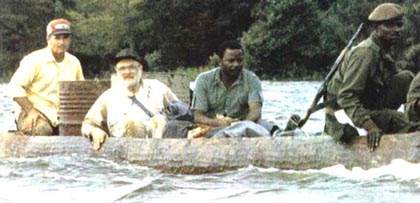
Roy Mackal, in the Congo, in search of Mokele-mbembe.
In July 1996, Scott learned how to create web pages and decided to create a page on Mokele-mbembe. At the same time, he began searching for general information about cryptozoology on the internet, and discovered online resources were scare. Scott decided to start his own web site on cryptozoology in general, which he called “Cryptozoological Realms.”
Soon, via the web, Scott Norman met Bill Rebsamen, Karl Shuker, Bill Gibbons, John Kirk, Chad Arment, and me. Scott joined Bill Gibbons in working on some future planning for possible cryptozoology expeditions.
Soon, Scott Norman, via his work as web developer, was helping many cryptozoologists create their sites. Eventually, he was made President of CryptoSafari: Exploring the World’s Hidden Wonders, a non-profit cryptzoological and scientific research organization.
One of Scott’s long-term projects, during these website constructions, has been to put the descriptions of all the cryptids in the world on the internet. It remains an on-going objective today.
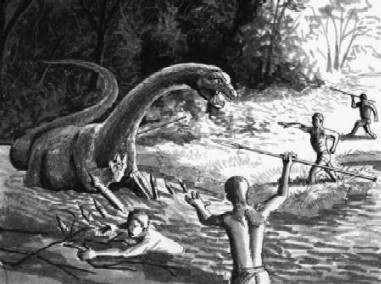
Drawing of Mokele-mbembe by Bill Rebsamen, used with permission.
In February 2001, in a joint venture between CryptoSafari and the British Columbia Scientific Cryptozoology Club (BCSCC), Scott Norman became a member of a research team, which traveled to the Republic of Cameroon in central-western Africa to investiage reports of Mokele-mbembe sightings.
The North American expedition team consisted of Scott, Dr. William J. Gibbons, BCSCC president John Kirk and writer Robert A. Mullin. Administrative support in the US was provided by Jackie Raffa.
In Cameroon, the team was joined by a video crew from the BCC News and by local guide Pierre Sima Noutchegeni. After an initial exhausting trek through the outer fringes of the rainforest, they were further joined by ten Baka pygmy guides and porters, who were themselves privy to sightings and information about the elusive Mokele.
It was during a break in the ongoing trek to search for Mokele-mbembe signs that the pygmies told of the existence of a fierce creature they had tracked through the forest for seven consecutive days during the previous month, in January 2001. Along with Pierre, the pygmies had discovered three-toed humanlike footprints on the forest floor and realized that they were those of an animal known to them as the Dodu.
John Kirk has written that “after pointing out possible candidates for the creature knew as Mokele-mbembe,…a group of villagers began to leaf through the binder and when they reached the last page they happened upon the Kalanoro, drawn by Harry Trumbore and featured in Loren Coleman’s book The Field Guide to Yeti, Bigfoot and Mystery Primates Worldwide. As one, the gathered throng collectively cried out: ‘Dodu!'”

Harry Trumbore’s drawing of Africa’s kalanoro, from The Field Guide to Bigfoot and Other Mystery Primates. Copyright 2006, Loren Coleman and Patrick Huyghe.
The Dodu is said to resemble the Kalanoro or Kalenourou, a protopygmy hairy biped that reportedly inhabits Madagascar.
Next, Scott Norman and John Kirk were paired off as a subteam to investigate the upper reaches of a river on whose banks the expedition had established its campsite. Along with two Bantu boatmen, Scott and John ran sonar tests in the depths of the river. They found no signs of Mokele-mbembe, however. Nevertheless, strange occurrences would happen with lines and equipment being pulled into the water by animals unseen.
The expedition team’s work gathering interviews continued. When showing natives drawings to identify what cryptids were being seen, the locals would reject the Mackal book’s illustration of a small sauropod dinosaur and point instead to a much larger sauropod—the brachiosaur. Scott reported the village erupted almost as one with the cry: “Mokele-mbembe!!!!!!”.
When Scott visited me in Maine, we talked also of the remarkable reports of a frill on the neck of Mokele-mbembe. Robert Mullin’s theory is the “cock’s comb” commonly described on the Mokele is the developing dorsal frill of an adolescent.
Certainly, for Scott, the 2001 experience is one he wishes to repeat, and he feels there is much more to learn out there in the running waters in the rainforests of central Africa.
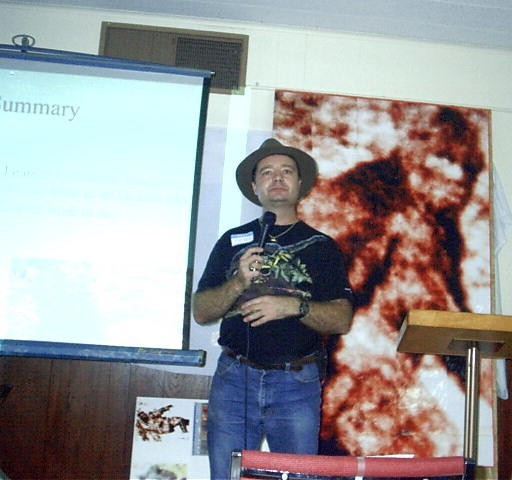
Back from the jungles, Scott decided to give lectures on his adventure. Here is Scott Norman speaking at the Texas Bigfoot Researchers Conference in Jefferson.
Of course, for anyone that goes to darkest Africa, the dangers one faces upon returning may be more scary – from the media. For example, because Scott has been to Africa, often the press wants to characterize him as some Victorian “Indiana Jones” on a fruitless insane quest for living dinosaurs, and appoint him as the point man for all of cryptozoology.
You may have seen Scott T. Norman on the awful “Penn and Teller” profram on cryptozoology. The two comedians ridiculed Scott terribly, making fun of his model dinosaurs and his hat. But Scott has survived.
Indeed, the fedora has become a proud trademark of Scott’s.
That hat caused me some lapsed memory moments, I must admit. I was so confused early on before I’d actually met Scott in person in Texas, about who was Scott T. Norman, that I got Scott and Matt Bille mixed up.


Scott Norman, left, and Matt Bille, right.
I’m not sure how that confusion could have ever happened, humm?
Those two wearing fedoras threw me, a bit. (Matt Bille is a science, history, and fiction writer living in Colorado Springs, Colorado, who has authored two cryptozoology books, Rumors of Existence, and Shadows of Existence.)
When Scott visited on October 20th, this year, I put on my fedora (I don’t wear it except for photo op humor) for the traditional photograph in front of the museum Bigfoot (below).
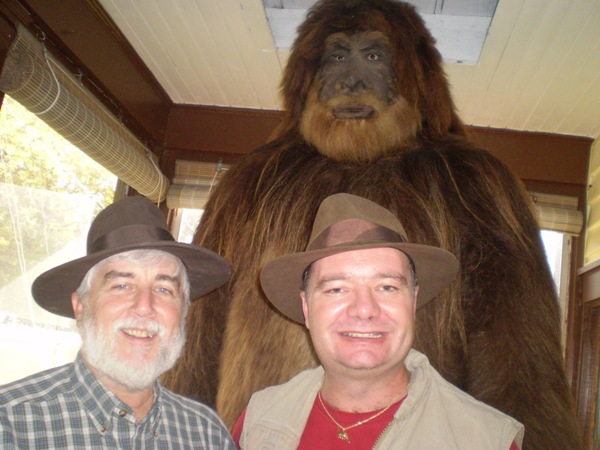
Scott Norman (right) trekked from California to Maine, and visited Loren Coleman (left) at the International Cryptozoology Museum, October 20, 2007, on the anniversary of the Patterson-Gimlin Film.
Perhaps I should begin a collection of photographs of cryptozoologists wearing fedoras. 🙂
Scott T. Norman is one of the good guys in cryptozoology. He is a man who is calm, intelligent, and now thinking creatively about how to make his various life missions combine into his next African dinosaur pursuit.
About Loren Coleman
Loren Coleman is one of the world’s leading cryptozoologists, some say “the” leading living cryptozoologist. Certainly, he is acknowledged as the current living American researcher and writer who has most popularized cryptozoology in the late 20th and early 21st centuries.
Starting his fieldwork and investigations in 1960, after traveling and trekking extensively in pursuit of cryptozoological mysteries, Coleman began writing to share his experiences in 1969. An honorary member of Ivan T. Sanderson’s Society for the Investigation of the Unexplained in the 1970s, Coleman has been bestowed with similar honorary memberships of the North Idaho College Cryptozoology Club in 1983, and in subsequent years, that of the British Columbia Scientific Cryptozoology Club, CryptoSafari International, and other international organizations. He was also a Life Member and Benefactor of the International Society of Cryptozoology (now-defunct).
Loren Coleman’s daily blog, as a member of the Cryptomundo Team, served as an ongoing avenue of communication for the ever-growing body of cryptozoo news from 2005 through 2013. He returned as an infrequent contributor beginning Halloween week of 2015.
Coleman is the founder in 2003, and current director of the International Cryptozoology Museum in Portland, Maine.

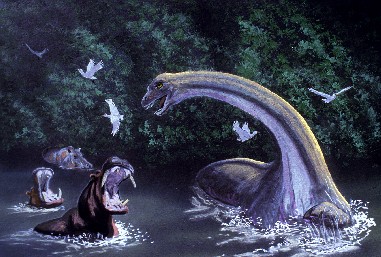









Great article.
Agreed. Terrific article, Loren, and thanks for “introducing” me [us] to Scott Norman. A very interesting bit of information was this: “When showing natives drawings to identify what was being seen, they would reject the Mackal book’s illustration of a small sauropod dinosaur and point instead to a much larger sauropod—the brachiosaur. Scott reported the village erupted almost as one with the cry: “Mokele-mbembe!!!!!!”.” That certainly changes my perception of what this beast is (or more properly, may be). I aways had a bit of a problem with the idea of a “mini” sauropod killing full grown hippos-something more along the lines of a brachiosaur doing so is more tenable to me.
Interesting man. He sure has a passion of cryptozoology and the Mokele-Mbembe!
You two sure look like peas in a pod from that photo, Loren. Yes, interesting article indeed.
so, do I have to go out and get one of those hats to be considered a true cryptozoologist? cool article.